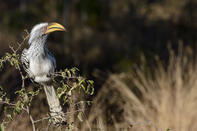
Name
Southern yellow-billed hornbill - Tockus leucomelas
Appearance
The yellow-billed hornbill is a medium sized bird, at 50 cm in length. This hornbill has grey upperparts and mostly white underparts. A black strip runs down the back of the neck. They have a long tail and a typical hornbill bill, long, curved and yellow in colour. Only the male’s bill has a casque. The face is grey-streaked, with pink facial skin and the eye is yellow.
This hornbill is distinguished from other hornbills by its yellow bill.
Diet
The yellow-billed hornbill is an omnivore, feeding mostly on insects, small mammals and amphibians, but will feed on fruit and seeds. They feed mainly on the ground.
Southern Yellow-Billed Hornbill Breeding
The yellow-billed hornbill nests in natural tree cavities. The female will seal herself inside the cavity, using a mixture of mud and her own dung. To facilitate feeding, she will leave a small hole so the male can feed her and the chicks.
The female incubates two to four eggs for around 25 days and she will remain in the nest with the chicks until the nest becomes too small. At this point, the female will let herself out and reseal the nest with the chicks inside. The feeding of the chicks is done by both parents. At around 45 days from hatching, the chicks will break out of the nest and start foraging with the parents a couple of days later.
Behaviour
The southern yellow-billed hornbill becomes very tame around humans.
Threats
None.
Southern Yellow-Billed Hornbill Distribution and Habitat
The yellow-billed hornbill is found in a wide range of grassland, savanna, inland wetlands and forest across the eastern and northern parts of South Africa.
By Karl Svendsen